Sean Patterson
“Death to All Those who Stand in the Way of Freedom for the Working People”
Anarchy’s False Flag
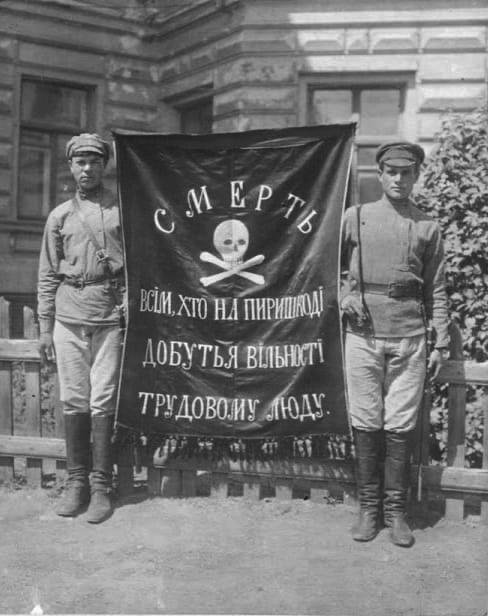

In pursuing the recovery of the past, the near inevitability of error is a perpetual thorn in the side of historians. Ranging from small typos to translation errors to source manipulation, historical inaccuracies can be introduced into authoritative academic texts in a multiplicity of ways. Sometimes error is a matter of carelessness or the unintentional mis-reading of a text; in other cases, the introduction of error is linked to authorial biases, or even the intentional falsification by state authorities for political purposes. Many textual errors are mere nuisances that have little to no broader implications for their subject, while other errors can over time spawn historiographical consequences that outweigh their initial appearance. The subject of the Ukrainian Civil War’s peasant-anarchist Makhnovist movement provides numerous examples of historiographical myth production. In this article I investigate the case of one flag, which turns out to be a false flag, in order to illustrate how a seemingly minor historical error can create enduring ripples that far outweigh its initial transgression.
The Makhnovists were a popular peasant movement based in the southern Ukrainian province of Katerynoslav [modern-day Zaporizhia oblast] during the years of Revolution and Civil War (1917–1921). Their leader, Nestor Makhno, was an anarcho-communist from a poor peasant background, who as a youth was convicted for terrorist crimes and sentenced to life in prison. However, after the 1917 Revolution Makhno was released and he returned to his hometown, Huliaipole, where he organized a successful insurgent movement. His forces fought against virtually every competing power including the Imperial German Army, the White Army, the Ukrainian People’s Army, the Red Army, and various other local forces.
The movement’s ideological leadership sought to create a society of federated peasant communes and worker-controlled industries administered through freely elected councils outside of party-control. However, due to the contingencies of the Civil War their social experiments were consistently disrupted. Moreover, the leadership often struggled to control elements of its army which engaged in looting and atrocities.[1] Against this background, Makhno’s forces were frequently accused of anti-Semitism and carrying out ethnic pogroms – an accusation that Makhno and his supporters defended themselves from both during the Civil War and later in exile. It is in the context of the debate around these accusations that the flag in question first emerges.
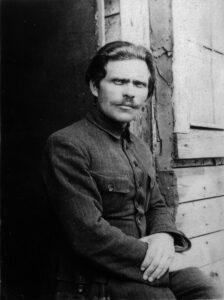
A key example of the myth-producing power of error and manipulation within Makhnovist historiography is the black flag that has become the movement’s central symbol, displaying the skull-and-crossbones and a slogan in white Ukrainian lettering that reads, “Death to all who stand in the way of freedom for the working people” [“Smertʹ vsim, khto na pereshkodi dobut’ia vilʹnosti trudovomu liudu”].[2] The flag is widely recognized both within Ukraine and internationally. It is especially ubiquitous in online anarchist communities, inspiring innumerable memes and entire lines of merchandise including T-shirts, stickers, cell phone cases and even pandemic masks. However, despite its near-universal reputation as the primary symbol of Ukrainian anarchism, the flag is not Makhnovist.
In academic and popular literature of various languages, the skull-and-bones flag has been consistently identified as Makhnovist since at least the 1970s.[3] In the digital era, Wikipedia has been especially important in tying the flag to Makhno in the broader public mind. Until very recently most related Wikipedia articles uncritically labelled the flag as Makhnovist. This has been corrected to some extent of late. For example, the entry “Flags of the Makhnovshchina” – created in June 2022 – correctly notes that the flag is not Makhnovist but incorrectly ascribes it to Symon Petliura’s Ukrainian People’s Army.[4] In other entries and in the Wikimedia Commons the flag is still described as Makhnovist or “allegedly” Makhnovist.[5] Given Wikipedia’s broad cultural reach, it is likely that the site acted as a significant vector in reinforcing the flag’s association with Makhno, particularly with online anarchist communities. As an open-source collaborative platform, Wikipedia is especially prone to such errors and the spreading of mythologies about under researched and highly politicized topics like the Makhnovist movement.
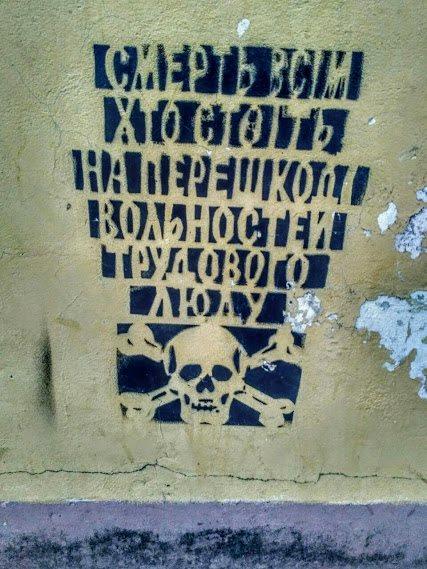
Within Ukraine itself, the flag and its slogan is widely seen in street graffiti, artworks, historical films, and even official museum exhibits like the one in Nestor Makhno’s hometown of Huliaipole. The slogan, and variations thereof, are also seen on frontline Ukrainian soldiers’ patches and flags in the current war with Russia. Ukrainian and Russian anarchist organizations frequently evoke the flag and slogan in their propaganda. In the context of today’s war, the slogan is understood as a Ukrainian rallying cry for resistance against the Russian state’s invasion.
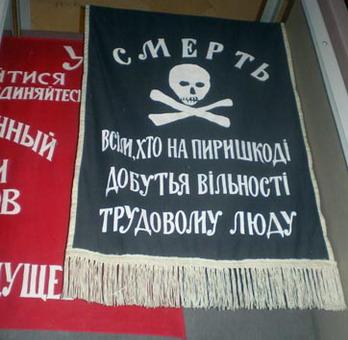
The original archived photo of the flag depicts it held aloft by two soldiers with sabers in front of a large stone building. Within the USSR, the photo first appeared in Zelʹman Ostrovskii’s 1926 publication entitled Jewish Pogroms, 1918–1921.[6] The book documented the Civil War’s outburst of anti-Semitic violence, which by contemporary estimates resulted in roughly 50,000 Jewish deaths.[7] An early Bolshevik propaganda strategy was to label their ideological enemies as the instigators of these ethnic pogroms. This was the primary purpose of Ostrovskii’s book, which took particular aim at Civil War-era Ukrainian nationalists and independent peasant movements.[8]
Interestingly, Ostrovskii mentions the Makhnovists only twice in the book’s text. In the first instance, Ostrovskii identifies Makhno, as one of the “chief inspirers of the pogromist bands” and asserts that it was only during Makhno’s temporary alliances with the Bolsheviks that he was restrained from committing pogroms. In the second mention, Ostrovskii states that the Makhnovists operated in the Poltava and Katerynoslav provinces, and includes them in an ignoble list of “bandits” who “reveled in the suffering of their Jewish victims”.[9] Ostrovskii offers no discussion of any specific pogroms allegedly committed by Makhno.
By contrast the Makhnovists feature more prominently among the book’s photos. These include images of Makhnovist units, Makhno himself, and and the famous black flag photo.[10] Photos of alleged Makhnovist violence are also provided including mutilated corpses of victims from Oleksandrivsk in the summer of 1919 and a mass grave of 175 victims from the Jewish colony Trudoliubovka.[11] It is in this context that the skull-and-bones flag first appears as part of an early Soviet effort to visually link Makhno to Jewish pogroms through the strategic use of a memorable symbol and slogan.
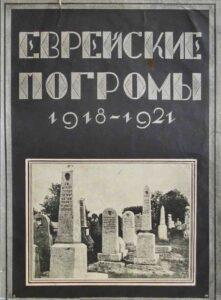
Researchers and Civil War survivors have long debated the historical role of anti-Semitism in the Makhnovist movement. In recent decades the scholarly consensus amongst specialists is that Makhno himself was not an anti-Semite and that his movement included many prominent Jews.[12] Moreover, it is recognized Makhno issued many orders condemning ethnic chauvinism and demanding the death penalty for pogromists.[13] On the other hand, evidence from the movement itself shows that anti-Semitism had infected the rank-and-file level to a degree and that pogroms were committed by Makhnovist units in confirmed instances.[14] The exact relationship between anti-Semitism and the Makhnovists became a point of serious contention in post-civil war émigré circles, in which Makhno vociferously refuted all charges until his death in 1934.[15]
While living in exile in France, Makhno consulted a copy of Ostrovskii’s book and in 1927 published an article entitled “To the Jews of All Countries”. In it he rejects the charge that he was an anti-Semite. He emphasizes how some of the movement’s leading figures were Jewish, and that “revolutionary fighting units made up of Jewish workers played a role of prime importance in the movement”.[16] He also notes that Ostrovskii conveniently avoided discussing pogroms committed by the Symon Budonnyi’s 1st Red Army Cavalry. Regarding the photos depicting a Makhnovist pogrom in Oleksandrivsk, Makhno correctly notes that “it is common knowledge in Ukraine that at the time in question [summer 1919] the Makhnovist insurgent army was far from that region: it had fallen back into western Ukraine”.[17] Indeed, Oleksandrivsk was occupied in summer 1919 by Red and White forces but at no point during this period by Makhno’s army.[18] Makhno also comments on the “the photograph purporting to show ‘Makhnovists on the move’ behind a black flag displaying a death’s head”, asserting that “this is a photo that has no connection with pogroms and indeed does not show Makhnovists at all”.[19] Finally, Makhno notes that one of the pictures supposedly depicting him under the mocking title “Makhno – a peaceable citizen” is in fact “someone absolutely unknown to me”.[20] Unfortunately for Makhno, his protests over the skull-and-bones flag would go unheeded and over time its symbol and slogan would become exclusively associated with his movement – although not in a manner he nor Ostrovskii would have ever imagined.
As for the photo itself, there was reason to believe Makhno’s disavowal. Firstly, the slogan is in the Ukrainian language, and, while the vast majority of Makhnovists were ethnic Ukrainians, the movement’s literature and slogans were almost exclusively published in Russian.[21] Secondly, the soldiers holding the flag do not look like typical Makhnovist partisans, who often wore mismatched outfits rather than identical uniforms. Nonetheless, these red flags, as it were, did not prove Makhno’s claim. Moreover, the photo’s official entry in the Ukrainian archives lists it as “Banner of the Makhnovists. 1920”.[22]
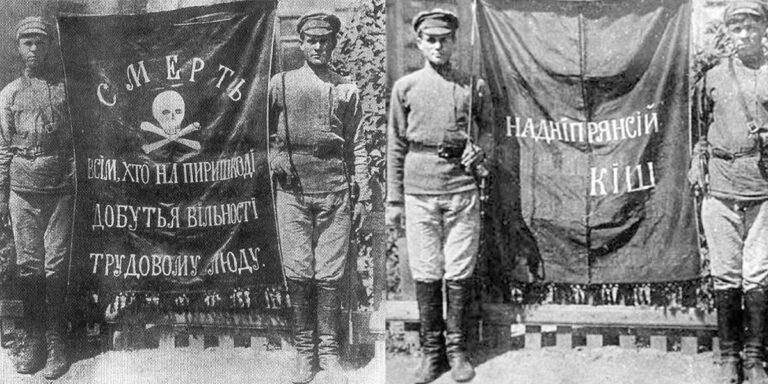
However, it turned out that the photo was part of a larger set that included a separate photo of the same soldiers displaying the flag’s reverse, which reads “Naddnipriansʹkyi Kish”.[23] “Kish” is a Cossack term that originally described a military encampment or settlement. During the Ukrainian Civil War, the term was used to indicate something approximating an army division.[24] Thus the flag’s inscription roughly translates to the “Dnipro Division”. However, the Makhnovists never used the term “kish” and indeed this division belonged not to Makhno but to a different Ukrainian insurgent, named Svyryd Kotsur.[25]
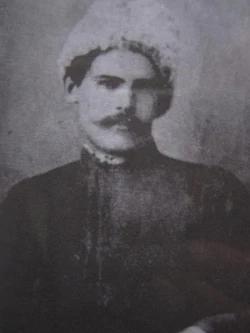
Kotsur’s career mirrored Makhno’s in uncanny ways. Like Makhno, Kotsur self-identified as an anarcho-communist – although one historian described his philosophy more as a “combustible mixture” of anarchism, nationalism, and Bolshevism, allegedly once referring to himself as “a Bolshevik but not a Communist”.[26] Also like Makhno, Kotsur briefly carved out an autonomous region, and fought every force with which he came into contact. He was even referred to as “Little Makhno” and in some photographs bore a striking resemblance to Makhno.
Svyryd Dementiovych Kotsur was born to a large peasant family on January 30, 1890 in the small central Ukrainian village of Subotiv (Chyhyryn district, Kyiv province). From an early age Svyryd and his brothers were involved in political activity. Like Makhno, prior to the Revolution Kotsur joined an anarcho-communist group and was arrested for participating in a Katerynoslav bank robbery. Makhno himself was briefly acquainted with Kotsur in these early days. In March 1910 Makhno was facing a court martial in Katerynoslav for terrorist offences. He describes in his memoirs how on the fourth day of his trial the session was suspended due to gunshots just outside the courtroom. A number of days later, Makhno recalls that “in our cell in the basement, we encountered Comrade Kotsur, who told us he was the cause of the shooting on the fourth day of the trial”.[27] Kotsur explained that his shootout with the police lasted a full day during which he injured seven guards and killed one secret police agent.[28] He told Makhno he was now awaiting trial and expected to be hanged.[29] Fate would turn out quite differently for the pair, as despite being sentenced to death, both would have their sentences abruptly commuted to hard labour. The pair also found themselves released from prison after the February 1917 Revolution due to the government’s amnesty of political prisoners. Makhno and Svyryd each returned to their native regions where in parallel they built formidable movements centred around their charismatic leadership.
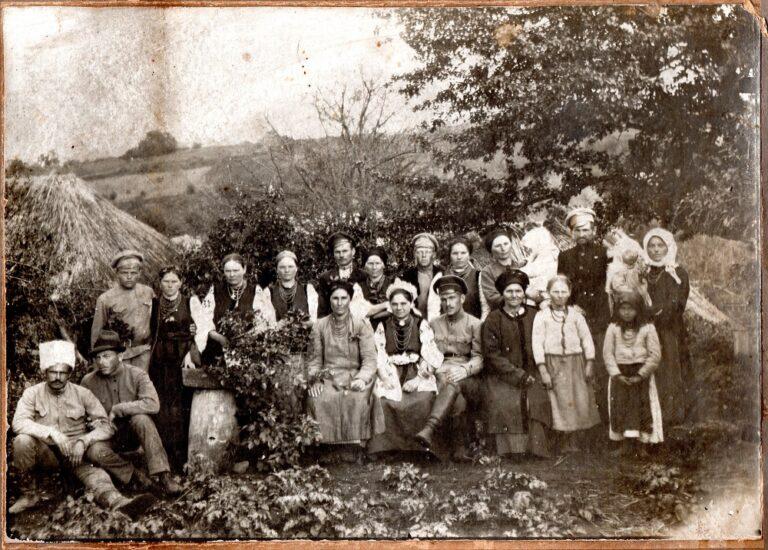
In the early days of the Revolution, Kotsur was elected as one of 2,000 delegates to the All-Ukrainian Congress of Free Cossacks in Chyhyryn. The Congress resolved in favour of Ukrainian autonomy and demanded the withdrawal of all Russian troops. This declaration was rendered moot when the Bolsheviks negotiated a peace treaty with the German Imperial Army. The latter occupied Ukraine from April-November 1918, during which Kotsur was elected leader of the Chyhyryn insurgent committee to lead the underground resistance against the Germans. Kotsur raised an effective detachment and even successfully dislodged the Germans from Chyhyryn in November.
Following the German Army’s withdrawal from Ukraine, Kotsur engaged in a dizzying array of strategic alliances with the Civil War’s competing forces. Kotsur initially sided with the Bolsheviks against Petliura’s nationalist forces. Subsequently, when the Bolsheviks were pushed out of Ukraine by Denikin’s White Army in fall 1919, Kotsur briefly allied with Makhno from September until the return of the Red Army in January 1920. However, relations between Kotsur and the Bolsheviks quickly soured as he refused to cooperate with orders that led him outside his home region. In January Kotsur ordered a visiting Bolshevik delegation to be drowned in a well. After this event, Kotsur declared an independent Chyhyryn republic and the formation of the Dnipro Kish.
Kotsur’s territory was more of a micro-republic encompassing a mere four settlements. Nonetheless, Kotsur initially successfully defended his territory against the Bolsheviks and various local atamans allied with the Ukrainian People’s Army. In February 1920, Kotsur successfully defended Chyhyryn against a Red raid with the help of a Makhnovist unit stationed there. However, by March 30 his forces were overwhelmed and the Red Army successfully occupied Chyhyryn. The death of Kotsur has many versions and it is not clear exactly when he died. The official version states that Kotsur was captured and shot shortly after the Bolshevik occupation. Other stories have Kotsur surviving and travelling to Bulgaria, while a local legend claimed a man closely resembling Kotsur himself would frequently visit the grave of Svyryd Kotsur in the 1980s. In a ghostly parting shot to history a small note signed by Kotsur was found in 2018 hidden inside an artillery shell bearing the words: “One who is for freedom and their native land knows no fear: Freedom or death!” The note was found with a newspaper from 1923 adding fuel to the fire of speculation that at least one of the Kotsur brothers survived 1920.[30]
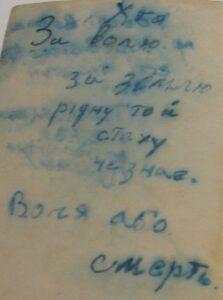
How the skull-and-bones flag photo came to be labelled as Makhnovist is unclear. While Kotsur briefly allied with Makhno between September and December 1919, Kotsur did not form his Dnipro Kish until January 1920.[31] Moreover, if the photo was taken in 1920, as indicated in the archives, then this occurred after the Kotsur-Makhno alliance had expired. Although the fact that Makhnovists were present and acting alongside Kotsur’s forces in some capacity until at least February 1920 suggests a possible explanation for photo’s mistaken archival description. It is also unknown whether Ostrovskii intentionally misattributed the photo to the Makhnovists or simply repeated an error already present in the archival catalogue.
To confuse matters further, the soldiers holding the flag are likely not even Kotsur’s soldiers. Another photo from the archived set depicts the same soldiers in front of the same stone building holding a different flag: this time a horizontally bi-coloured one (likely yellow and blue) with the inscription “Free Ukraine”. The photo description indicates this is a flag from the 1st Cavalry Cossack regiment “Free Ukraine” of the Ukrainian People’s Army and that the soldiers holding it are Red Army soldiers. A third person now appears behind the flag wearing a black leather jacket – the preferred fashion of Bolshevik intelligence officers.[32] This suggests that the photo set is of Bolsheviks displaying captured battle flags.
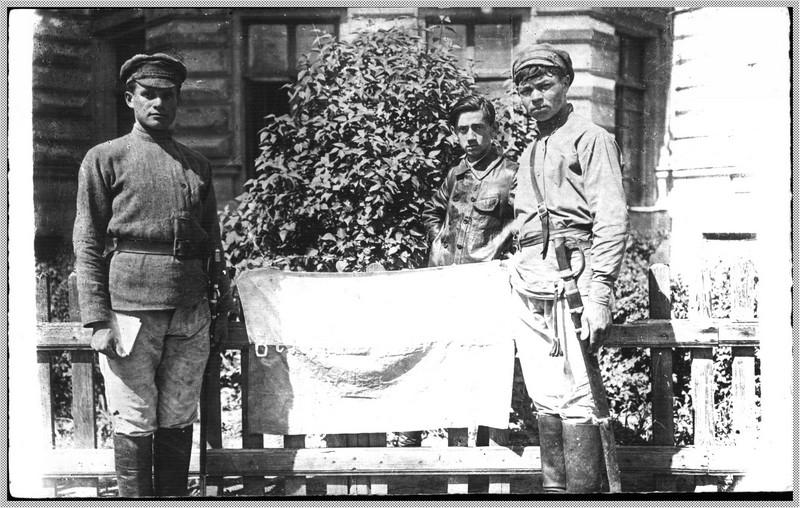
Two final pieces of evidence complete the flag’s puzzle. An identical copy of the black flag photo was discovered in the Russian State Military Archives during the preparation of a Civil War photo album published in 2018. The entry for this photo reads “Flag of P. Kotsur’s Band”, suggesting the flag was specifically associated with Svyryd Kotsur’s brother Petro.[33] In fact, the supposed photo of Makhno produced by Ostrovskii, which Makhno irritatedly rejected, bears a striking resemblance to Petro Kotsur.
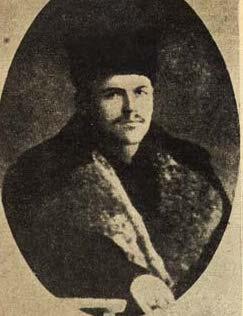
After Svyryd’s apparent death in March 1920, his brother Petro took up the cause of resistance against the Bolsheviks in Chyhyryn. It is not clear how long the region’s insurgents continued their fight. However, a telegram from the Revolutionary Military Soviet of the South-Western Front dated June 26, 1920 reported that Red Army units in the Chyhyryn area “completely defeated the bands of Petrenko and Kotsur. Kotsur himself, his assistants, and Chief-of-Staff were killed … The black banner of the Zadneprovskiy regiment [polk] was taken”.[34] While the preposition “za”, meaning beyond, is used instead of “nad”, meaning over, the telegram is highly suggestive. Unfortunately, at this stage it cannot be proven beyond doubt that the referenced black banner is in fact the same one as depicted in the photo. However, if it is, then it offers a plausible scenario for the photo’s origins. Taken as a whole the current state of evidence suggests the original photo depicts Red Army soldiers displaying a captured flag from Petro Kotsur possibly sometime after June 26, 1920. The exact location of the photo and the unit to which the Red Army soldiers holding the flag belong remains unknown.
Through this dizzying labyrinth of Civil War regiments, archival entries, and Bolshevik propaganda, an enduring myth was produced. To what extent do its origins matter? Does the fact that this beloved Makhnovist symbol of freedom and popular resistance is not Makhnovist after all diminish its contemporary power on the frontlines or rupture its established chain of meaning? Will the Reddit memes of a Chad Makhno behind the skull-and-bones flag fall into disrepute? These are questions that only the communities that actively engage the flag and its slogan can ultimately answer. However, I suspect the flag will remain a vibrant part of anarchist and Ukrainian symbology.
Since the flag’s first appearance in Ostrovskii’s 1926 book, the flag has become completely divorced from its origins. It has cycled through a multitude of meanings from an ignoble marker of alleged Makhnovist pogroms to an international source of inspiration for anarchist resistance to a symbol of regional pride and a declaration of defiance against Russian invasion. In one form or another the flag and its slogan will surely survive and continue its march through time.
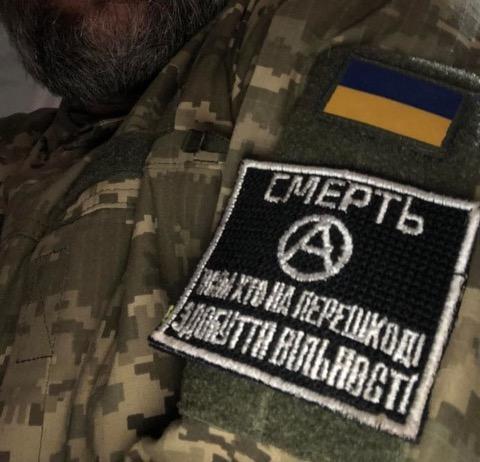
[1] For literature about Makhnovist violence see Sean Patterson, Makhno and Memory (Winnipeg: University of Manitoba Press, 2020); A.I. Beznosov, “Die Nikolaipoler Mennonitensiedlungen in den Jahren des Bürgerkriegs (1918–1920)”. Nord-Ost Institut. 2019. https://www.ikgn.de/cms/index.php/uebersetzte-geschichte/beitraege/beznosov-die-nikolaipol- er-mennonitensiedlungen; Mikhail Akulov, “Playground of Violence: Mennonites and Makhnovites in the Time of War and Revolution”, International Relations and Diplomacy 3 (7): 439–447; Felix Schnell, Räumes des Schreckens (Hamburg: Hamburger Edition, 2012); Arno J. Mayer, The Furies: (Princeton: Princeton University Press, 2000); N.V. Venger, “Nestor Makhno ta ‘nemetsʹke pytannia’ na ukrainsʹkykh zemliakh” in C.C. Troiana, ed., Persha svitova viina i revoliutsii vektory sotsiukulʹturnykh transformatsii (Kyiv: Kondor, 2017), 30–62; and John B. Toews, ed., Mennonites in Ukraine Amid Civil War and Anarchy (Fresno: Center for Mennonite Brethren Studies, 2013).
[2] The original flag’s spelling does not conform with modern Ukrainian. The exact lettering in transliteration reads “Smertʹ vsyim, khto na pyryshkodyi dobutʹia vyil’nostyi trudovomu liudu”. It is hard to speak here of spelling errors or typos given that during this period Ukrainian spelling was not yet fully standardized and commonly varied by region.
[3] For example, the flag is included in Viktor Belash, Dorogi Nestora (Kyiv: Proza, 1993); Peter Arshinov, History of the Makhnovist Movement (London: Freedom Press, 2005); Semanov, S.N. “Pod chernym znamenem, ili zhiznʹ i smertʹ Nestora Makhno” Roman-Gazeta 4 (1993); Valerii Volkovynsʹkyi, Nestor Makhno (Kyiv: Perlit prodakshn, 1994); Vasilii Golovanov, Nestor Makhno (Moscow: Molodaia gvardiia, 2008); and Felix Schnell, Räumes des Schreckens. The earliest attribution of the flag to Makhno in Western literature I found was in “Makhno”, Le Monde Libertaire 182 (1972): 9.
[4] “Flags of the Makhnovshchina”, https://en.wikipedia.org/wiki/Flags_of_the_Makhnovshchina. The Russian entry for “The Insurrectionary Movement led by Nestor Makhno” also correctly labels the flag as “pseudo-Makhnovist”. https://en.wikipedia.org/wiki/Повстанческое_движение_под_руководством_Нестора_Махно
[5] For example, see the entries “Anarchism in Ukraine”, https://en.wikipedia.org/wiki/Anarchism_in_Ukraine; “Makhno, Nestor Ivanovich”, https://ru.wikipedia.org/wiki/Махно,_Нестор_Иванович; and “Makhno’s Flag”, https://commons.wikimedia.org/wiki/File:Makhno%27s_flag.jpg
[6] Zelʹman Ostrovskii, Evreiskie pogromy, 1918–1921 (Moscow: Akts. obshchestvo «Shkola i kniga», 1926), 100.
[7] Henry Abramson. “Russian Civil War”. YIVO Encyclopedia of Jews in Eastern Europe, November 22, 2010, https://yivoencyclopedia.org/article.aspx/Russian_Civil_War
[8] Ibid. Abramson breaks down the perpetrators of Jewish pogroms as follows: 40 percent – Symon Petliura’s Ukrainian forces; 25 percent – independents; 17 percent – White Army; 9 percent – Red Army.
[9] Ostrovskii, Evreiskie pogromy, 28; 72.
[10] Ibid., 39, 102, 103, 95, 100.
[11] Ibid., 37, 47, 111, 112, 131.
[12] See Paul Avrich, Anarchist Portraits (Princeton: Princeton University Press, 1988), 122–123. After examining hundreds of photos in New York’s YIVO archive, Avrich concluded that the accusations of anti-Semitic violence “are based on hearsay, rumor, or intentional slander, and remain undocumented and unproved”. The Mennonite historian Victor Peters, who cannot be accused of pro-Makhnovist views in any sense, argued that Makhno did not attack Jews or Mennonites on the basis of ethnic hatred. Victor Peters, Nestor Makhno (Winnipeg: Echo Books, 1970), 106–107. See also Michael Malet, Nestor Makhno in the Russian Civil War (London: MacMillan Press, 1982), 168; Colin Darch, Nestor Makhno and Rural Anarchism in Ukraine (London: Pluto Press, 2020), 53; Alexandre Skirda, Nestor Makhno: Anarchy’s Cossack (Oakland: AK Press, 2004), 336–341; Patterson, Makhno and Memory, 21, 25. I have confined myself to English language sources here but Russian and Ukrainian specialists likewise agree that Makhno was not a personal anti-Semite.
[13] For example see “Prikaz Batʹko Makhno No. 1”, Putʹ k svobode, No. 29, November 21, 1919. For an English translation see Peter Arshinov, History of the Makhnovist Movement (London: Freedom Press, 2005), 214–216. A resolution from the Makhnovist February 12, 1919 Congress explicitly condemned “plunder, violence, and anti-Jewish pogroms” carried out under the name of the movement. Palij, The Anarchism of Nestor Makhno (Seattle: University of Washington Press, 1976), 155.
[14] For example see the emergency resolution of Nabat anarchists within the movement, which specifically mentions anti-Semitism as a problem amongst troops. “Rezoliustiia ekstrennogo soveshchaniia aktivnykh rabotnikov konfederatsii Nabat”, in Kriven’kii, V.V., et al., ed. Anarkhisty: dokumenty i materialy. Tom 2 (Moscow: ROSSPEN, 1999), 287. The movement also directly addressed and condemned the Gorkaia pogrom in their newspaper. P. Mogila, “Gde zhe konets nasilie”, Put’ k Svobode, No. 2, May 24, 1919. According to Belash and Makhno its perpetrators were executed after an investigation. See Belash, Dorogi Nestora Makhno, 215–216 and Nestor Makhno, “The Makhnovshchina and Anti-Semitism”, in Alexandre Skirda, ed., The Struggle Against the State and Other Essays (Oakland: AK Press, 1996), 34–35. Jewish anarchist and Makhnovist leader Volin claims that the famous pogrom historian Elias Tcherikower told him in an interview that the “Makhnovists behaved best with regard to the civil population in general and the Jewish population in particular and that “not once have I been able to prove the presence of a Makhnovist unit at the place where a pogrom against Jews took place”. Volin, The Unknown Revolution (Oakland: PM Press, 2019), 698. By contrast, Tcherikower wrote in a private letter that, “there cannot be the slightest doubt that he [Makhno] is implicated in a series of pogroms. I have enough substantiated evidence in my archive to show that his men were exactly the same sort of bandits as all the others. Whether they perpetrated the pogroms with his permission or on their own initiative is difficult to say; either way – he is responsible”. Cited in Brenden McGeever, The Bolshevik Response to Antisemitism in the Russian Revolution (Cambridge: Cambridge University Press, 2019), 135.
[15] For the most comprehensive discussion on anti-Semitism and Makhno in English see Michael Malet, Nestor Makhno, 168–174; For Makhno’s personal defence see Nestor Makhno, “K evreiam vsekh stran”, Delo truda 23–24 (1927): 8–10 and “Makhnovshchina i Antisemitizm”, Delo truda 30–31 (1927): 15–18. Translated into English as “To the Jews of All Countries” and “The Makhnovshchina and Anti-Semitism” in Skirda, ed., The Struggle Against the State, 28–31; 32–38.
[16] Makhno, “To the Jews of All Countries”, 28.
[17] Ibid., 30. It is more accurate to say central Ukraine. The furthest west Makhno found himself at this time was Umanʹ in the most southern part of Kyiv province [guberniia].
[18] Makhno occupied Olesksandrivsk on two occasions: January 1918 with the Red Army; October-November 1919. Malet, Nestor Makhno, 7; 47.
[19] Makhno, “To the Jews of All Countries”, 30.
[20] Ibid.
[21] An exception was the Makhnovist Ukrainian language newspaper Shliakh do voli [Path to Freedom]. It was published in the fall of 1919 during the Makhnovist occupation of Katerynoslav. However, the newspaper was a product of a short-lived alliance with the Borotbists – a socialist Ukrainian nationalist movement. The newspaper was under the editorship of the Borotbists and, while distinctively pro-Makhnovist, displayed a level of Ukrainian national consciousness uncommon in other Makhnovist publications. For a discussion on Makhnovist banners and propaganda see Yuriy Kravetz, “Znamena povstancheskoi armii N. Makhno. 1918–1921 gg”. Muzeinyi visnyk 7 (2007): 127–137; Yuriy Kravetz and Andrei Federov, “Agitatsiia i propaganda Makhnovskogo dvizheniia”, Pivdennyi zakhid. Odesyka. Istoryko-kraeznavchyi naukovyi alʹmanakh 24 (2018): 50–85.
[22] TsDKFFA Ukraine [Central State Cinema and Photo Archive] 0–53894. A copy of the photo is also held in the Elias Tcherikower Archive in New York. It is labeled “Flag of Makhno”. YIVO Archives Record Group 80, Series IV, Folder 642.
[23] TsDKFFA Ukraine 0–235665. As with the flag’s front side, the reverse’s spelling deviates from modern Ukrainian, reading “Nadnyipriansii Kish”.
[24] “Free Cossacks”, Internet Encyclopedia of Ukraine, http://www.encyclopediaofukraine.com/display.asp?linkpath=pages%5CF%5CR%5CFreeCossacks.htm. Kish was particularly associated with the Free Cossacks and units of Petliura’s army. This explains why the Wikipedia authors of the “Flags of the Makhnovshchina” attributed the flag to the Ukrainian People’s Army. Kish did not always refer to a “division”. For example, Petliura’s Haidamatskyi Kish Slobidskoi Ukrainy referred to a battalion.
[25] Reliable works on Kotsur are limited, although a few studies offer a glimpse into his life and movement. Foremost are Oleksandr Solodar’s writings, in which he extensively consulted the State Archives of Cherkassy Oblast. Oleksandr Solodar, “Zvyvysti shliakhy Svyryda Kotsura” Istorichni storinky “Nova Doba” No. 61 (August 6, 2002): 2–3. Viktor Savchenko’s book on Ukrainian atamans also includes a fairly detailed survey of Kotsur’s career. V.A. Savchenko, Avantiuristy grazhdanskoi voiny (Kharkiv: Folio, 2000), 200–239. See also O. Minsʹka, “Svyryd Kotsur: Fakty i Manipuliatsiyi”, in V.M. Lazurenko, ed., Personalistychnyi vymir istoriyi Cherkashyny: materialy Pershoyi regionalʹnoyi istoryko-kraeznavchoyi konferentsiyi (Cherkasy: 2018), 184–191. Unless otherwise indicated I drew from Solodar’s work to provide Kotsur’s biography.
[26] Savchenko, Avantiuristy, 233.
[27] Nestor Makhno, “My Autobiography”, in Malcolm Archibald, ed., Young Rebels Against the Empire (Edmonton: Black Cat Press, 2021), 30, 33. This text was originally published in Russian, French, and German anarchist newspapers Rassvet (1926), Le Libertaire (1926), and Der freie Arbeiter (1927).
[28] This event is confirmed by an archival file that directly references Kotsur’s “armed resistance to the police in Ekaterinoslav”. GARF [State Archives of the Russian Federation] F. 102, op. 207, d. 729. I thank Yuriy Kravetz for drawing my attention to this file.
[29] Makhno, “My Autobiography”, 33–34.
[30] “U Kholodnomu Iaru znaideno snariadnu hilʹzu z povstansʹkymy dokumentamy”, Kozatsʹkyi krai, April 26, 2018, http://cossackland.org.ua/2018/04/26/u-holodnomu-yaru-znajdeno-snaryadnu-hilzu-z-povstanskymy-dokumentamy/?fbclid=IwAR3hgvWbjjB6gWCzbanXy4mzjXn2_lUyY4MYGnsaulL_WtCFVGSWSFBsFXE
[31] Some sources give July 1919 as the date of formation for the Kish, but here I am preferencing Solodar’s research due to his extensive knowledge of the regional archives.
[32] Iaroslav Tychenko, Novitni Zaporozhtsi: Viis’ka tsentral’noyi rady (Kyiv: Tempora, 2010), 109. This picture is clearly part of the same photo session but the dated indicated is spring 1918. This is either an error or possibly an indication of when flag was first captured. As the Dnipro Kish did not exist prior to January 1920, these photos could not have occurred earlier than that date.
[33] R.G. Gagkuev, E.E. Koloskova, and Iu.D. Andreikina, eds., Grazhdanskaia voina v Rossii v fotografiiakh i kinokhronike. 1917–1922 (Moscow: Kuchkovo pole, 2018), 206. Yet again a different year is given for the photo. The description gives 1919, however the year of 1920 given in the Ukrainian archival entry is more likely as I argue for in this article.
[34] TsDAVO Ukraine [Central State Archives of Supreme Bodies of Power and Government of Ukraine] F. 2, op. 1, d. 744, ark. 25. The telegram is written in Russian. Thank you to Yuriy Kravetz for this archival reference. Kravetz is a Zaporizhia-based historian of Makhno. He has written extensively on the Makhnovist movement and is the first researcher that I am aware of to question the flag’s Makhnovist origin. See Yuriy Kravetz, “Znamena povstancheskoi armii N. Makhno. 1918–1921 gg”.
